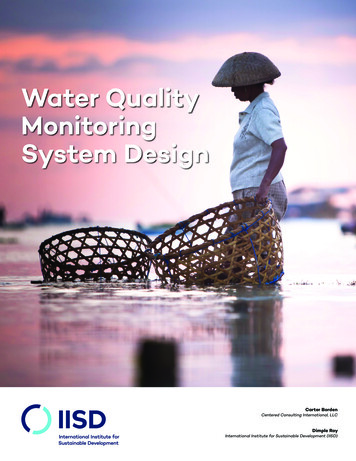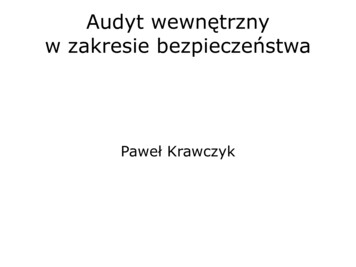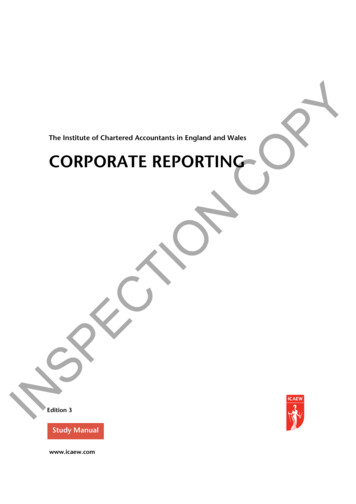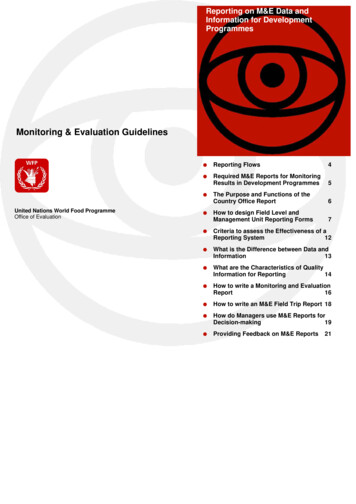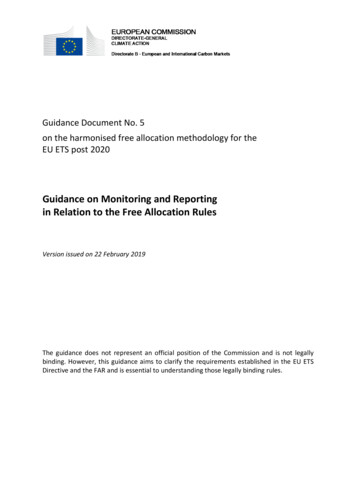
Transcription
Guidance Document No. 5on the harmonised free allocation methodology for theEU ETS post 2020Guidance on Monitoring and Reportingin Relation to the Free Allocation RulesVersion issued on 22 February 2019The guidance does not represent an official position of the Commission and is not legallybinding. However, this guidance aims to clarify the requirements established in the EU ETSDirective and the FAR and is essential to understanding those legally binding rules.
Table of contents1INTRODUCTION .41.1Scope of this guidance document .41.2Where to find Guidance Documents .52QUICK GUIDE TO M&R FOR ALLOCATION RULES .62.1Where should I start reading? .62.2What is new in Phase 4 regarding monitoring and reporting in the context offree allocation? .92.2.1 Relevant new elements of the Directive . 92.2.2 New elements in the FAR . 92.2.3 New elements on verification . 112.3Considerations for specific installation situations . 112.3.1 Installations with low emissions . 112.3.2 New entrants . 122.3.3 Renunciation of free allocation . 122.3.4 Mergers and splits . 123THE EU ETS COMPLIANCE CYCLE (OR: THE MRVA SYSTEM IN GENERAL) . 134CONCEPTS AND APPROACHES . 154.1What are benchmarks and sub-installations in the EU ETS? . 154.2What are “inputs, outputs and emissions” of a sub-installation? . 164.3Attributed emissions . 234.4Further rules on splitting data into sub-installations . 234.5Example for splitting an installation into sub-installations . 244.6Terms used in the MRR and AVR (emissions monitoring) . 314.7Terms introduced by the FAR important for monitoring . 345THE MMP . 385.1The MMP content . 385.2Developing the MMP . 395.3Approval of the MMP. 425.3.1 Timing . 425.3.2 Different focus of MMP in the first NIMs round and thereafter. 435.3.3 Verification without approved MMP . 455.4The improvement principle – approval of MMP updates . 455.5The control system. 475.6Avoiding and closing data gaps . 475.6.1 Temporary deviations from the approved MMP . 472
5.6.25.6.36Missing data. 48Conservative approaches . 49MONITORING RULES . 506.1Overview of FAR monitoring rules . 506.2Overarching principles . 516.3Installation level data and split to sub-installations . 526.3.1 Use of sub-meters . 526.3.2 Split into sub-installation without direct metering . 556.4Direct vs. indirect data determination . 566.5Examples of indirect determination methods and correlations . 576.6Selecting the most accurate data source. 596.6.1 Hierarchy of data sources . 606.6.2 Technical feasibility and unreasonable costs . 646.6.3 Simplified uncertainty assessment . 666.7Handling of units used by several sub-installations . 676.8Monitoring of production levels . 686.9Monitoring of measurable heat . 696.10Rules on CHP. 706.11Rules on cross-boundary heat flows . 716.12Detailed heat balance . 716.13Determining the boundaries of the fuel BM sub-installations . 746.14Determining the boundaries of the process emissions sub-installations . 756.15Rules for Waste gases . 776.16Monitoring of electricity . 777ANNEX A – CENTRAL CONCEPTS . 797.1What are benchmarks and sub-installations in the EU ETS? . 797.2Product benchmarks and “fall-back” sub-installations . 827.3Attributed emissions . 837.3.1 Examples: General introduction . 887.3.2 Examples: Fuel and material input only (FM). 897.3.3 Examples: Measurable heat flows (MH) . 907.3.4 Examples: Waste gases (WG) . 977.3.5 Examples: Electricity (Elec) . 1018ANNEX B – ABBREVIATIONS. 1033
11.1INTRODUCTIONScope of this guidance documentThis guidance document is part of a group of documents, which are intended to supportMember States and their Competent Authorities throughout the Union in the consistentimplementation of the allocation methodology for the fourth trading period of the EU ETS(post 2020). The methodology is established by the Commission Delegated Regulationadopted on 19 December 2018 on “Transitional Union-wide rules for harmonised freeallocation of emission allowances pursuant to Article 10a of the EU ETS Directive” (the “Freeallocation Rules”, FAR). Guidance Document 1 on General Guidance to the AllocationMethodology provides an overview of the legislative background to the group of guidancedocuments. It also explains how the different Guidance Documents relate to each other andprovides in its Annex a glossary of important terminology used throughout all the guidancedocuments.The current document covers the following main areas: First, a “quick guide” is provided for the reader new to the topic of free allocation in thefourth phase of the EU ETS (chapter 2); Chapter 3 gives an overview of the FAR-related (annual) “compliance cycle”, and chapter 4introduces the essential concepts relevant for monitoring of data relevant for benchmarkingin the EU ETS; The chapters 5 and 6 provide guidance on the monitoring and reporting requirementsintroduced by the FAR, and specifically requirements for the monitoring methodology plan(MMP); Annexes provide an in-depth discussion of the important concepts “sub-installation” and“attributed emissions”, as well as an overview of definitions, acronyms used and legislativetexts.Note on outstanding issues in this version of the Guidance DocumentAs decision-making on the allocation methodology is not yet finalized, certain elements of thisGuidance Document are as yet undefined. This especially includes issues related to theimplementing act still to be adopted on the detailed rules on the changes to allocations of freeallowances and the update of the benchmark values. In addition, it can also apply toreferences to the outstanding legislation itself or to accompanying Guidance Documents thatare still to be prepared or finalized.4
1.2Where to find Guidance DocumentsAll the Commission’s guidance documents, FAQs and templates in relation to the freeallocation rules can be found wances en#tab-0-1In addition, the Commission has provided an extensive suite of guidance material in relationto MRVA (Monitoring, Reporting, Verification and Accreditation) under the EU ETS 1. The userof the current document is assumed to be familiar with at least the basic principles of toring en#tab-0-1 – see in particular the section “Quickguides”5
2QUICK GUIDE TO M&R FOR ALLOCATION RULESThis chapter provides three tools for getting a quick overview to the rules on free allocationin the fourth EU ETS phase (2021-2030): Section 2.1 gives hints to different stakeholders (operators, verifiers, competent authoritystaff, national accreditation bodies) on which guidance documents provide them with thefastest way to learn the new concepts needed for free allocation in the EU ETS phase 4.Section 2.2 provides a quick overview of new elements in the legislation for phase 4,including more specific references to chapters of this guidance document.Section 2.3 provides brief additional information for operators of installations in certainsituations (new entrants, installations which may be excluded from the EU ETS, renunciationof allocation, mergers and splits).2.1Where should I start reading?The ideal entry point for reading about Monitoring, Reporting and Verification (MRV) inrelation to the Free Allocation Rules (FAR) depends on your profession as well as your previousexperience with the EU ETS. While this document is designed to be generally understandablewithout first reading other documents, it also attempts to avoid repetition from otherdocuments as much as possible. Depending on your situation, the following apply: Operator of an installation, that has already provided data for free allocation in the thirdphase (2013-2020) of the EU ETS: You will be interested in changes to the allocation methodology for the 4th phase. Startby reading section 2.2 of this document, before you decide which other sections arerelevant for your installation. As you will have to prepare a Monitoring Methodology Plan (MMP), don’t miss chapter 5of this document. Timelines and responsibilities are given in chapter5.3. Thereafter other documents in this series (as mentioned in section 1.2) should beconsulted: For ensuring correct reporting of your baseline data, refer to guidancedocument (GD) number 3. For details on the new allocation process, an explanation isprovided in Guidance 2, including how to split an installation into sub-installations. For the MMP, you will have to understand the underlying monitoring rules and concepts.They are described in the present document, chapters 4 to 6. Depending on your installation, you may be also be interested in rules for transfers ofheat between installations (explained in GD 6), treatment of waste gases in the FAR (seeGD 8), and GD 9 which explains in detail system boundaries and special data requirementsfor all product benchmarks.Operator of an installation that is new to the topic of free allocation in the EU ETS: You are advised to start by reading GD 1 of this series (the source for these documents isgiven in section 1.2) on the overall allocation methodology, followed by GD 2 for learningabout splitting an installation into sub-installations.6
Before you start preparing your installation’s monitoring methodology plan, you will alsofind GD 3 on the completion of the reporting template useful for understanding what kindof data will be required in the baseline report. For the latter process, continue readingthe current document, in particular chapters 4 to 6. Depending on your installation, you may also be interested in rules for transfers of heatbetween installations (GD 6), treatment of waste gases in the FAR, and GD 9 whichexplains in detail system boundaries and special data requirements for all productbenchmarks. Due to the relationship between annual emissions monitoring (in line with the MRR) andthe monitoring required by the FAR you may also find it useful to get acquainted with thebasic principles of the MRR. This is the purpose of the MRR “Quick guide for stationaryinstallations” and MRR guidance document No. 1 “The MRR general guidance forinstallations”.Operator of an installation classified as an “electricity generator”, or installation for thepurpose of capture, transport or geological storage of CO2, which does not produce heat orother products eligible for free allocation: In principle such installations are not eligible for free allocation under Article 10a of theDirective. However, for confirming this status the operator will find it useful to get intouch with the responsible Competent Authority (CA). Some CAs may still require theoperator to confirm this situation, e.g. by submitting an (empty) baseline report (noverification necessary). Reading any of the FAR related guidance documents is optional.The Commission’s guidance on the identification of electricity generators2 is useful. If the installation is situated in one of the Member States eligible for granting supportunder Article 10c of the EU ETS Directive (“Option for transitional free allocation for themodernisation of the energy sector”), it is advisable to get in touch with the CAresponsible for the implementation of that Article.Operator of an installation that intends to renounce its free allocation: Section 2.3.3 of this document should help to understand the consequences ofrenunciation of free allocation, as well as related roles, responsibilities and timelines. If after reading that section you come to the conclusion, that you still want to apply forfree allocation for your installation, please go ahead as described above for otheroperators.Operator of a new entrant: A new entrant is an installation which has received its greenhouse gas emissions permit(i.e. the permit issued in accordance with Articles 5 and 6 of the EU ETS Directive) after30 June 2019 or 30 June 2024, respectively. While the requirements on monitoringmethodology plans and providing data needed for allocation to the CA are similar andbased on the same principles of the FAR, the timing of submissions will be different. Please refer first to section 2.3.2 of this document, as well as to guidance document No.7 (“Guidance on new entrants and closures”), before continuing as advised for “Operatorof an installation, who is new to the topic of free allocation” above. docs/guidance electricity generators en.pdf7
Aircraft operator: Free allocation to aircraft operators is not subject of Article 10a of the EUETS Directive. Please refer to the MRR “Quick guide for aircraft operators”, and MRRguidance document No. 2 “General guidance for Aircraft Operators” for monitoring issues.Verifier: Guidance document 4 specifically deals with verification of data required by the FAR. Furthermore, for understanding of the requirements imposed on the operator, it isadvisable to read the same documents suggested above for “operators new to the topicof free allocation in the EU ETS”. As guidance document 4 advises, the general principles of EU ETS verification should beknown to verifiers. For this purpose, refer to the guidance material provided for the AVR,in particular EGD I: “The Accreditation and Verification Regulation – ExplanatoryGuidance Document No.1”, or the AVR Quick Guide for Verifiers (for references seesection 1.2).Competent authority with experience in the 3rd phase: You will be interested in changes to the allocation methodology for the 4th phase. Startby reading section 2.2 of this document, before you read further sections of thisdocument. Thereafter other documents of this series (as listed in section 1.2) should be consulted.Competent authority staff new to the topic of free allocation: You are advised to start by reading GD 1 of this series (the source for these documents isgiven in section 1.2) on the overall allocation methodology, followed by GD 2 to learnabout splitting an installation into sub-installations. You will also find GD 3 on the completion of the reporting template useful forunderstanding what kind of data will be required in the baseline report, as well aschapters 4 to 6 of the current document on requirements for installations’ monitoringmethodology plans. Further guidance documents in this series should be consulted on a case-by-case basisdepending on the installations falling within your competence.National accreditation bodies (NABs): The current document will provide you with an understanding of the different kinds ofdata the verifier has to handle as compared to the annual emissions data under EU ETSverification. This will provide you with a better understanding of GD 4 (verification of FARdata), which will be your primary information source when it comes to supervision ofverifiers performing FAR data verification. The general principles of EU ETS verification, however, can be learned from the guidancematerial provided for the AVR, in particular EGD I: “The Accreditation and VerificationRegulation – Explanatory Guidance Document No.1”. There is also an AVR Quick Guidefor NABs (for references see section 1.2).8
2.2What is new in Phase 4 regarding monitoring and reporting in thecontext of free allocation?2.2.1 Relevant new elements of the DirectiveCompared to the free allocation rules for phase 3, the following elements are new in the EUETS Directive, and are reflected accordingly in the FAR: The length of EU ETS phase 4 is ten years (2021-2030), but allocation is calculated ex-antefor two separate “allocation periods” which are five years each (2021-2025 and 2026-2030).As basis for the allocation, “baseline data” has to be collected by Member States fromoperators. The respective “baseline periods” are 2014-2018 and 2019-2023, respectively,and are fixed in the Directive (Article 11(1)).The same Article ensures that free allocation can only be granted to operators who havesubmitted the relevant data (this submission is termed “baseline data report” in the FARand in this guidance).The benchmark values will be updated (Article 10a(2)) every five years based on the samedata collection, using years 2016-2017 and 2021-22 respectively. No change in the list ofbenchmarks is foreseen 3. This has extensive impact on the data requirements, since the“attributed emissions at sub-installation level” are required to calculate a benchmark. Thisconcept is explained in detail in sections 4.3 and 7.3 of this guidance.There will only be one list of sectors exposed to a significant risk of carbon leakageapplicable for the full ten years of phase 4.The following new elements apply regarding changes to the free allocation throughout theallocation periods: Only “greenfield plants” will be considered “new entrants” in line with a new definitionprovided by Article 3(h) of the Directive; Activity Level Changes will trigger allocation changes – detailed rules are yet to bedeveloped (“ALC” Regulation); Allocation changes will no longer be based on capacity changes – therefore there is noneed to monitor and report capacity information.2.2.2 New elements in the FARThe following elements are new in the FAR compared to the CIMs of the third phase: 3Detailed rules for monitoring and reporting of all data required for free allocation and forthe update of benchmark values are provided in the FAR Regulation, while in the third phaseBy way of derogation regarding the benchmark values for aromatics, hydrogen and syngas, the EU ETSDirective requires that these benchmark values shall be adjusted by the same percentage as the refineriesbenchmark in order to preserve a level playing field for producers of those products. Hence baseline datagathered for aromatics, hydrogen and syngas sub-installations will not be employed to update benchmarkvalues for these products. However, the FAR do not contain an exception for reporting the sub-installationattributed emissions and the underlying data for these product benchmarks.9
these were available only in guidance documents. These rules include the followingelements: Operators are required to have a “monitoring methodology plan” (MMP) as the basis fortheir monitoring. This follows the concept of the “methodology report” required in thethird phase. It does not only cover the description of data sources used for historic data,but also provides the forward-looking approaches for actual monitoring of detailed datasets over time.The MMP must be approved by the competent authority (CA), just like the monitoringplan (MP) under the Monitoring and Reporting Regulation (MRR) applicable for annualemissions. However, due to timing constraints it is acknowledged that such approval maynot be possible in time for submission of the first baseline data report (in 2019).Therefore, unless the CA decides to require prior approval, the verifier will have tovalidate the MMP for the first submission of baseline data reports, similar to what wasdone with methodology reports for the third phase; this entails checking that it is incompliance with the FAR. The minimum content of the MMP is defined in Annex VI of the FAR. The Commission haspublished a template for the MMP. The FAR contain detailed rules for splitting installation into sub-installations (Article 10),on avoiding double counting and omissions, and on attributing emissions to subinstallations for the purpose of benchmark update (Annex VII section 10). Sections 4.3and 7.3 of this document explain these rules. The FAR contain detailed rules for selecting most accurate data sources. Compared to theMRR this concept provides a kind of “tiers light”, with a hierarchy provided for selectionof the data sources (section 4 of Annex VII of the FAR, explained in section 6.6 of thisdocument). An uncertainty assessment is required only for providing a reason to deviatefrom the main hierarchy of approaches. Like in the MRR, a key element for ensuring data quality is that the operator has toimplement a robust internal control system, which includes a risk assessment. Furtherinformation can be found in section 5.5. Similarly, continuous improvement of the MMP is required, but no improvement reportsare envisaged (Article 9 on updating the MMP). Guidance is provided in section 5.5. For minimising data gaps, the FAR foresee that – to the extent feasible without incurringunreasonable costs – alternative data sources have to be listed in the MMP, alongsidethe main source based on most accurate data sources. The operator can thereby alsoensure corroboration of the main data (see section 5.6).The minimum content of the baseline data report is given in Annex IV of the FAR. TheCommission has provided a template for ensuring EU-wide harmonisation of these reports.The FAR require baseline data reports to be verified by an accredited verifier, complyingwith the (revised) Accreditation and Verification Regulation (AVR). For more details pleasesee guidance document No. 4 on verification of FAR data.10
In order to receive free allocation, the operator has to submit an application for freeallocation, by a specified deadline 4 consisting of: A baseline data report; A verification report; The MMP used for the above reports, unless it has already been approved by the CA.Application for free allocation is voluntary. Operators can furthermore renounce freeallocation, e.g. if the administrative burden is perceived higher than the benefit from freeallocation. The operator is obliged to monitor and report the data as outlined in thisguidance only if he intends to apply for free allocation.The process of determining the free allocation has changed, in particular due to the updateof benchmark values. Further details can be found in Guidance Document No.1.The general architecture of the rules to calculate free allocation based on productbenchmarks, historic activity levels (HALs), fall-back approaches, and various correctionfactors, has remained largely unchanged.2.2.3 New elements on verificationDetailed rules for verification and accreditation of verifiers have been developed for FAR data.These rules are included in the revised AVR. Guidance document 4 gives extensive details onthe interpretation of those rules.2.3Considerations for specific installation situations2.3.1 Installations with low emissionsIf your installation falls into one of the categories covered by Articles 27 or 27a of the EU ETSDirective, your Member State may decide to exclude your installation from the EU ETS undercertain conditions (in the case of Article 27, equivalent measures have to be applied forincentivising emission reductions).If your Member State chooses this option, you have to get further guidance from yourcompetent authority. However, you will have to continue monitoring of annual emissions aswell as the data relevant for free allocation in order to be prepared for the situation that theinstallation exceeds the relevant thresholds for exclusion. You will also have to submit anMMP and baseline data report to your CA. However, the CA may put in place simplifiedrequirements for this purpose 5.45Article 5(1) of the FAR state “4 months before the deadline given in Article 11(1) of the EU ETS Directive” as adeadline (i.e. 31 May 2019 and 2024) as this deadline. However, Member States are given the option to movethis deadline one month forward or backward.In particular in case of exclusion pursuant to Article 27a(3), the MS may require monitoring of operating hoursonly.11
2.3.2 New entrantsA “new entrant” is any installation carrying out one or more activities listed in Annex I ofDirective 2003/87/EC which obtained a greenhouse gas emission permit after 30 June 2019for the first allocation period, and after 30 June 2024 for the second allocation period in Phase4. Therefore it means only greenfield plants6.If you operate such an installation, all the rules described in this guidance document inprinciple apply to your installation from the start of operation, with a few differences, such astiming of the MMP submission. For details please see section 5.3.1.2.3.3 Renunciation of free allocationOperators can renounce free allocation, e.g. if the administrative burden of MRV is perceivedto be higher than the benefit of free allocation. If the operator decides to renounce freeallocation at some time during the allocation period, Article 24 of the FAR provides the basisto do so. The installation will not receive free allocation from the year following the applicationby the operator until the end of the allocation period. Consequently, also the need formonitoring of FAR-related data will end by the CA’s approval of the renunciation.Note that there is no obligation for an operator to apply for free allocation at all by thedeadline given by the FAR. If the operator chooses this route, there is no need to monitor FARdata, and consequently no need to develop an MMP.However, if the operator decides to apply again for free allocation in a later allocation phase,he has to ensure that he has the relevant monitoring methodology in place in order todetermine the required baseline data. For timing of the MMP submission please see section5.3.12.3.4 Mergers and splitsIf you operate an installation emerging from a merger or a split of other installations, you willhave to ensure that the same data is reported as the former installations would have reported(i.e. the sum of previous activity levels must be identical to the sum of the later activity levels,etc.). This can usually be ensured by doing an analogous merger or split of the monitoringmethodology plan,
on the harmonised free allocation methodology for the EU ETS post 2020 . . fastest way to learn the new concepts needed for free allocation in the EU ETS phase 4. . ("Option for transitional free allocation for the modernisation of the energy "), it is advisable to get in touch with the sector CA .

